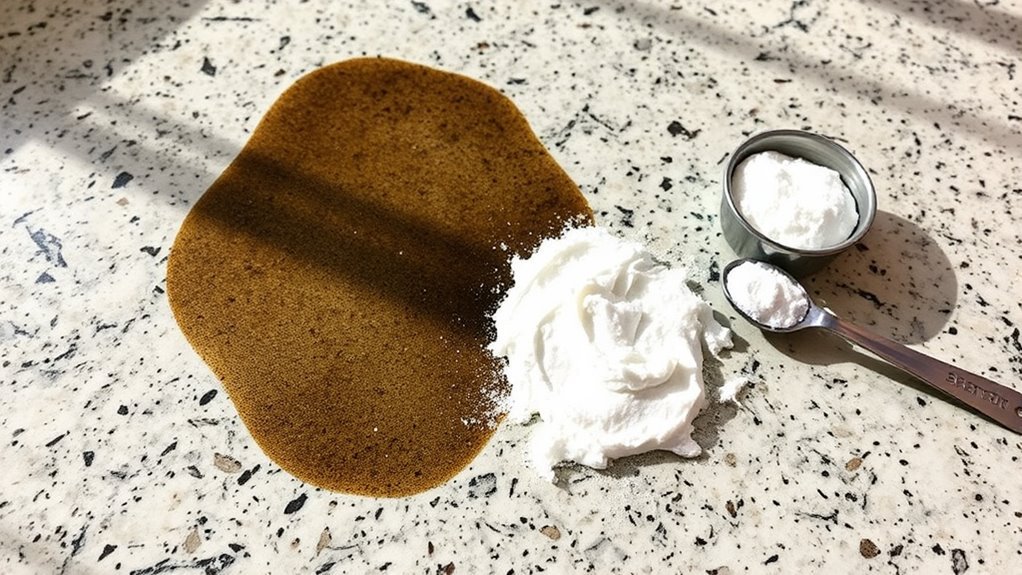How to Remove Stains From Granite Surfaces
To remove stains from granite, first identify the stain type—oil, water, organic, or rust. Prepare the surface by cleaning with a mild, pH-balanced cleaner and drying it thoroughly. For oil stains, apply a baking soda paste and cover for 24 hours before rinsing. Use hydrogen peroxide for organic stains by letting it sit for 10–15 minutes. Rust stains need special treatment to avoid damage. If you want to master granite care, there’s more helpful advice ahead.
Identifying Different Types of Stains on Granite

How can you tell what kind of stain you’re dealing with on your granite surface? Granite stain identification starts with understanding common stain types and their origins. You’ll typically encounter oil-based stains from cooking oils or cosmetics, water-based stains from beverages or cleaners, and organic stains from coffee, tea, or leaves. Rust or metal stains also show up as reddish or brown spots. Each stain type reacts differently to cleaning methods, so knowing what you’re facing is key to freedom from stubborn marks. A quick stain types overview helps you match the stain’s color and texture to its source. By accurately identifying the stain, you can choose the right approach, avoiding damage and preserving your granite’s natural beauty.
Preparing Your Granite Surface for Cleaning
Before you start tackling stains on your granite, you’ll want to prepare the surface properly to guarantee effective cleaning and prevent damage. Begin by clearing the area of any loose debris or dust using a soft, dry cloth. This step is essential in granite care to avoid scratching the surface during cleaning. Next, gently wipe the granite with a mild, pH-balanced cleaner diluted in water. Avoid harsh chemicals—they can strip the stone’s natural sealant. Rinse the surface with clean water and dry it with a soft towel to assure no residue remains. Proper surface preparation lets you work efficiently and protects your granite’s finish, giving you the freedom to clean confidently without risking stains or dulling the stone.
Using Baking Soda Poultices for Oil-Based Stains

Tackle oil-based stains on your granite by applying a baking soda poultice, a gentle yet effective method that draws out grease without harming the stone. This poultice application lets you reclaim your surface’s natural beauty while staying in control of the cleaning process.
Here’s how you can make and use your baking soda poultice:
- Mix baking soda with water to form a thick paste.
- Spread the poultice generously over the stained area.
- Cover it with plastic wrap and tape down the edges.
- Let it sit for 24 hours to absorb the oil.
- Remove the poultice and rinse the surface with water.
Removing Organic Stains With Hydrogen Peroxide
While baking soda poultices are great for oil-based stains, organic stains like coffee, wine, or food require a different approach. You’ll want to use hydrogen peroxide, which gently breaks down these organic stains without harming your granite’s surface. Start by applying a small amount of 3% hydrogen peroxide directly onto the stain. Let it sit for about 10 to 15 minutes, allowing it to lift the organic material. Then, gently blot the area with a soft cloth, avoiding any harsh scrubbing that could dull the finish. If needed, repeat the process until the stain fades completely. This method gives you the freedom to restore your granite’s natural beauty while handling organic stains safely and effectively.
Treating Rust Stains Safely on Granite

When tackling rust stains on your granite, it’s important to pick rust removers that are safe for stone surfaces to avoid damage. You’ll want to avoid acidic or abrasive cleaners that can dull the finish. Always test any product on a small, hidden area first to protect your granite’s natural shine.
Choosing Rust Removers
Rust stains on granite can be tricky, but choosing the right remover makes all the difference. When picking a rust remover, you want something effective yet gentle to keep your granite safe. There are several rust remover types designed specifically for stone surfaces, so look for those formulated for granite to avoid damage. Always follow safe application guidelines to protect both your countertop and yourself.
Consider these tips when selecting a rust remover:
- Opt for a pH-neutral or stone-safe formula
- Avoid acidic or abrasive cleaners
- Check product reviews for granite compatibility
- Use protective gloves and apply remover in a well-ventilated area
- Test remover on a small, hidden spot first
This way, you’ll tackle rust stains without sacrificing the freedom to enjoy your beautiful granite.
Protecting Granite Finish
Selecting the right rust remover is just the start; protecting your granite’s finish during treatment is equally important. To keep your surface looking flawless, always test any cleaner on a small, hidden area first. Avoid harsh chemicals that can break down granite sealants, compromising the stone’s natural resistance. After treating rust stains, rinse thoroughly to remove residues that might dull the finish. Regular surface maintenance, including resealing every 1-2 years, helps shield your granite from future damage and stains. Remember, maintaining that protective layer gives you the freedom to enjoy your beautiful granite without worry. Treat your granite with care, and it’ll reward you with lasting elegance and durability, making stain removal less frequent and less stressful.
Preventative Measures to Avoid Future Stains
Although granite is durable, preventing stains is much easier than removing them later. To keep your surfaces looking fresh and free from stubborn marks, you’ll want to focus on simple, consistent habits that protect your freedom to enjoy your space without worry.
Here are key preventative measures:
- Apply a high-quality sealant regularly to create a protective barrier.
- Stick to a routine of regular cleaning with gentle, pH-neutral cleaners.
- Wipe up spills immediately, especially oils and acidic substances.
- Use coasters and trivets under glasses and hot dishes.
- Avoid placing heavy or rough objects directly on the granite to prevent scratches that trap stains.
When to Call a Professional for Granite Stain Removal
Even with the best preventative steps, stains can still find their way onto your granite surfaces. When that happens, it’s essential to perform a thorough stain assessment. If the stain is deep, persistent, or you’re unsure how to tackle it, don’t hesitate to call in professional services. Experts have the right tools and knowledge to remove stubborn stains without damaging your granite’s natural beauty. Trying to fix complex stains yourself might lead to costly mistakes or permanent marks. So, if a stain resists your efforts or you want to guarantee your granite stays flawless, reaching out to professionals is the smart move. Remember, keeping your granite pristine supports your freedom to enjoy your space without worry.
Frequently Asked Questions
Can Granite Stain Removers Damage My Countertop’S Sealant?
You might worry that using granite stain removers could harm your countertop’s sealant, and that’s a valid concern. Not all stain removal products are created equal—some harsh chemicals can break down sealant protection over time. To keep your freedom to enjoy your beautiful granite, choose gentle, pH-balanced stain removers designed specifically for sealed stone surfaces. Always test on a small area first, so your countertop stays flawless and protected.
How Often Should I Reseal My Granite Surfaces?
You’ll want to check your granite’s resealing frequency every 1 to 3 years, depending on how much wear it gets. Sealant longevity varies with usage and the type of sealant applied, so testing it yourself is key—just sprinkle water on the surface; if it beads up, you’re good. If it soaks in, it’s time to reseal. Staying on top of this helps your granite stay protected and looking fresh without any hassle.
Are There Natural Alternatives to Chemical Stain Removers?
You’re in luck if you want to avoid harsh chemicals! Natural alternatives like baking soda are great for lifting stains—just make a paste with water, apply it, and let it sit before wiping away. A gentle vinegar solution can also work for tougher spots, but be careful since vinegar’s acidity might dull granite’s shine if overused. These options give you freedom to clean safely and naturally without compromising your surface’s beauty.
Can Granite Stains Affect Indoor Air Quality?
You might wonder if granite stains can affect your indoor air quality. While granite itself is a natural stone and generally safe, certain stains—especially from chemicals or mold—can release indoor pollutants that impact the air you breathe. To keep your space fresh and healthy, focus on stain prevention by sealing your granite surfaces properly and cleaning up spills quickly. This way, you maintain freedom in your home without worrying about hidden pollutants.
Is It Safe to Use Bleach on Granite Countertops?
You might think bleach is great for cleaning, but when it comes to granite maintenance, it’s not the best choice. Bleach effectiveness on granite stains is limited and can actually damage the stone’s sealant, making it more prone to stains and dullness. If you want to keep your countertops looking fresh and maintain their natural beauty, it’s better to stick with pH-balanced cleaners designed specifically for granite.






